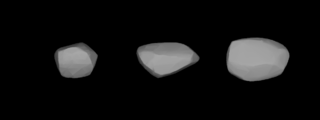
Prymno is a somewhat large Main belt asteroid. It is classified as a B-type asteroid and probably has a primitive composition not unlike common C-type carbonaceous asteroids.

Rosalia is a large Main belt asteroid. It was discovered by Auguste Charlois on 1 September 1891 in Nice.

Siri is a main belt asteroid in orbit around the Sun. It was discovered by German astronomer Max Wolf on 19 March 1892 in Heidelberg. The origin of this asteroid's name is unclear. On October 5, 2092, 332 Siri will pass 4,981,670 km (3,095,470 mi) from the asteroid 29 Amphitrite with a relative velocity of 2.054 kilometers per second.

Eduarda is a main belt asteroid that was discovered by German astronomer Max Wolf on 25 September 1892 in Heidelberg. It was named after German banker and amateur astronomer Heinrich Eduard von Lade.

Georgia is a typical Main belt asteroid. It is classified as an X-type asteroid.

Ducrosa is a typical Main belt asteroid. It was discovered by Auguste Charlois on 15 March 1895 in Nice.
Zähringia, provisional designation 1896 CZ, is a stony asteroid from the intermediate asteroid belt, approximately 14 kilometers in diameter. It was discovered on 7 September 1896, by astronomer Max Wolf at Heidelberg Observatory in Germany. The asteroid was named for the House of Zähringen, a medieval noble family that ruled parts of Swabia and Switzerland.

Patricia is a large Main belt asteroid.
Brixia is a relatively large minor planet, specifically an asteroid orbiting mostly in the asteroid belt that was discovered by American astronomer Raymond Smith Dugan on January 10, 1904. The name derives from Brixia, the ancient name of the Italian city of Brescia.
Montague is a minor planet orbiting the Sun that was discovered by Raymond Smith Dugan on 7 May 1904 in Heidelberg, Germany. It was named after the town Montague in Massachusetts.
Cheruskia is a minor planet, specifically an asteroid orbiting in the asteroid belt that was discovered by German astronomer Paul Götz on 26 July 1905 from Heidelberg.

Rebekka is a minor planet orbiting the Sun, which was discovered on September 19, 1905, by a German astronomer Paul Götz in Heidelberg. It was named after a young lady from Heidelberg, and may have been inspired by the asteroid's provisional designation 1905 RB.

Juvisia is a minor planet, specifically an asteroid orbiting in the asteroid belt that was discovered 27 August 1906 in Heidelberg by German astronomer Max Wolf. It was named after the commune Juvisy-sur-Orge, France, where French astronomer Camille Flammarion had his observatory.
639 Latona is a minor planet, specifically an asteroid orbiting in the asteroid belt. It was discovered by German astronomer Karl Lohnert on July 19, 1907, at Heidelberg.
691 Lehigh is a minor planet orbiting the Sun, discovered in 1909. It is named "Lehigh" after Lehigh University, where its orbit was calculated in the Masters Thesis of Joseph B. Reynolds, following the observations of amateur astronomer Joel Metcalf.
839 Valborg is a mid-sized S-type Eunomian asteroid. Its diameter is about 20 km, its albedo of 0.353 is very high for an asteroid. Its rotation period is 10.366 hours.
840 Zenobia is a minor planet orbiting the Sun. It was discovered by German astronomer Max Wolf at Heidelberg on September 25, 1916. The origin of the name is uncertain, but it may be named after the Slavic god of the hunt.
880 Herba is a minor planet orbiting the Sun that was discovered by German astronomer Max Wolf on 22 July 1917 in Heidelberg.
1817 Katanga, provisional designation 1939 MB, is a stony Phocaea asteroid in from the inner regions of the asteroid belt, approximately 16 kilometers in diameter. It was discovered on 20 June 1939, by English-born South African astronomer Cyril Jackson at Johannesburg Observatory in South Africa. It is named for the Katanga Province.
2278 Götz, provisional designation 1953 GE, is a dark background asteroid from the inner regions of the asteroid belt's background population, approximately 12 kilometers in diameter. It was discovered on 7 April 1953, by German astronomer Karl Reinmuth at the Heidelberg Observatory in southwest Germany. The F/C-type asteroid was named after astronomer Paul Götz.









